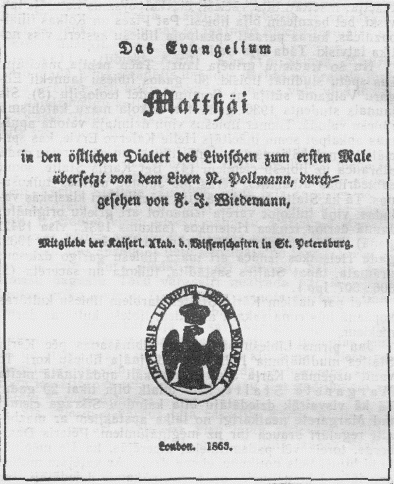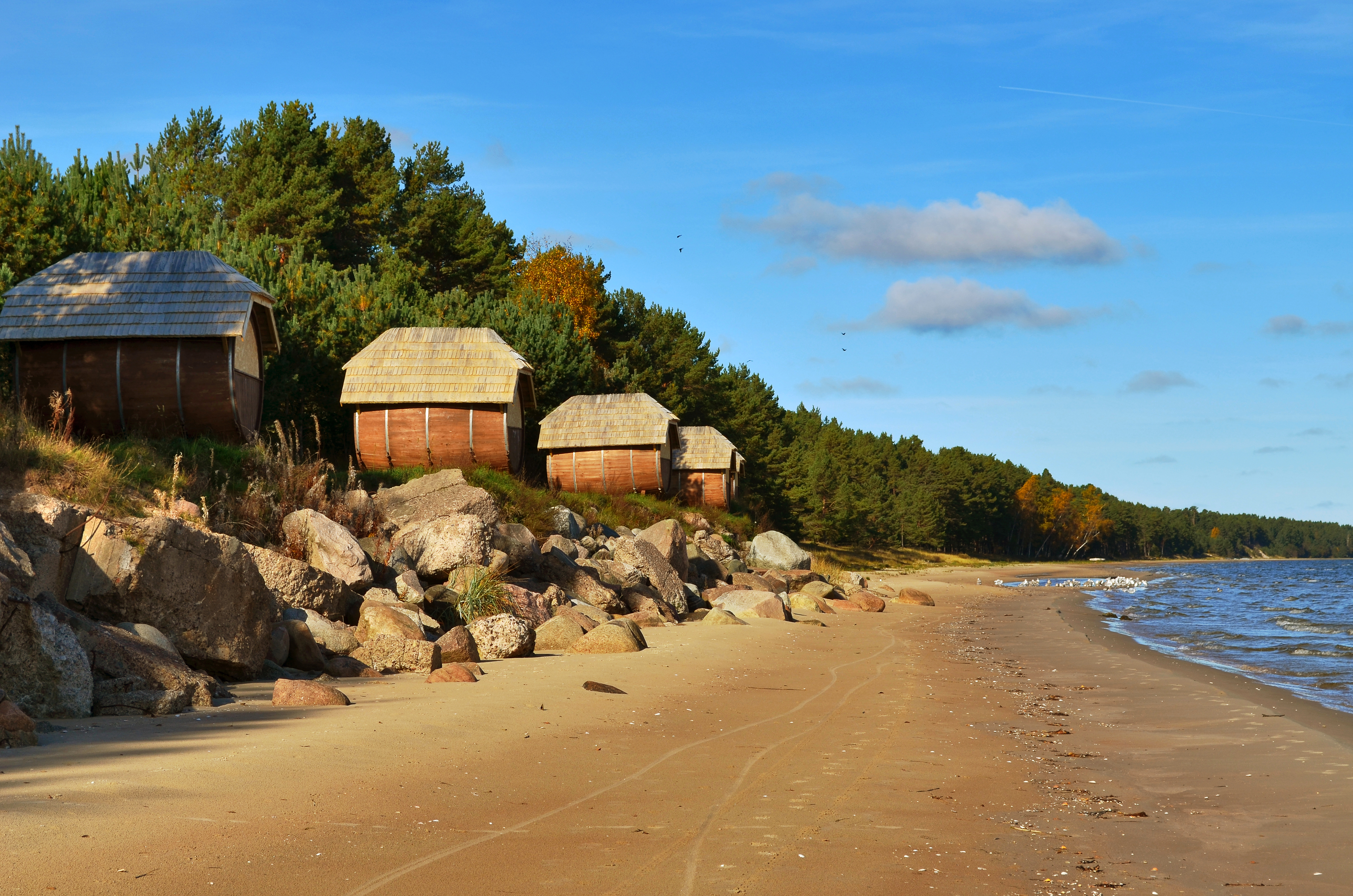|
Pitrags
Pitrags ( liv, Pitrõg) is a village situated in Kolka Parish, Talsi Municipality, in the Courland region of Latvia, at the mouth of the river Pitraga. It is one of twelve Livonian villages. Other names: Pitraguciems, Pitrag, Pitraga Ciems, Petragga, Pitraga, Pitragutsiyeme. It was founded in the Middle Ages by several brothers who arrived from Saaremaa and settled there. For many years, due to its geographical location on the river, Pitrags was a regional centre of shipbuilding, providing small timber fishing boats for locals and the nearby villages of Saunags and Vaide. During the Soviet period a large fish-smoking plant was located here (closed down in mid-1990s and now converted into a private residence). There is also a small local church and cemetery. Along the dunes runs the site of a narrow gauge railway, an extension of the military railway built to nearby Mazirbe during World War I. The railway was decommissioned in the 1960s, several years after a new strategic wide ... [...More Info...] [...Related Items...] OR: [Wikipedia] [Google] [Baidu] |
Līvõd Rānda
Livonian Coast ( liv, Līvõd Rānda, italic=no; lv, Lībiešu krasts, italic=no) is a territory of Latvia historically inhabited by Livonian people. It is located in Northern Courland and encompasses twelve Livonian villages. The protected area is about 60 kilometers long. On February 4, 1991, the Latvian government created a culturally protected territory called ' – the Livonian Coast – which included all twelve of the Livonian villages: Lūžņa (Livonian: Lūž), Miķeļtornis (Pizā), Lielirbe (Īra), Jaunciems (Ūžkilā), Sīkrags (Sīkrõg), Mazirbe (Irē), Košrags (Kuoštrõg), Saunags (Sǟnag), Vaide (Vaid), Kolka, Latvia, Kolka (Kūolka) (see also Cape Kolka), Pitrags (Pitrõg), and Melnsils (Mustānum). The Latvian government discourages new settlements here and prohibits alterations to historical village sites. Also, it is restricted for anyone to start a hotel, restaurant, or other public establishment which might adversely influence the Livonian cult ... [...More Info...] [...Related Items...] OR: [Wikipedia] [Google] [Baidu] |
Livonian Coast
Livonian Coast ( liv, Līvõd Rānda, italic=no; lv, Lībiešu krasts, italic=no) is a territory of Latvia historically inhabited by Livonian people. It is located in Northern Courland and encompasses twelve Livonian villages. The protected area is about 60 kilometers long. On February 4, 1991, the Latvian government created a culturally protected territory called ' – the Livonian Coast – which included all twelve of the Livonian villages: Lūžņa (Livonian: Lūž), Miķeļtornis (Pizā), Lielirbe (Īra), Jaunciems (Ūžkilā), Sīkrags (Sīkrõg), Mazirbe (Irē), Košrags (Kuoštrõg), Saunags (Sǟnag), Vaide (Vaid), Kolka (Kūolka) (see also Cape Kolka), Pitrags (Pitrõg), and Melnsils (Mustānum). The Latvian government discourages new settlements here and prohibits alterations to historical village sites. Also, it is restricted for anyone to start a hotel, restaurant, or other public establishment which might adversely influence the Livonian cultur ... [...More Info...] [...Related Items...] OR: [Wikipedia] [Google] [Baidu] |
Saunags
Saunags ( Livonian: ''Sǟnag'') is a populated place in Kolka Parish, Talsi Municipality, Latvia, located from the Cape Kolka, within the borders of Slītere National Park. The name derived from Livonian ''Sǟnag'' – pike perch (Sander), a local fish. First mentioned in documents in 1310, it is the oldest of the twelve Livonian villages on the Livonian Coast. It consists of two parts - Saunags and Dižsaunags, the later being the oldest and more preserved one. Located along the coast of the Baltic Sea and formerly inhabited by Livonian people. History and local landmarks Saunags is at the same latitude as Gothenburg (Sweden) and the same longitude as Turku (Finland), both important ancient regional trading and cultural centres. Although far from large towns and sparsely populated, this coastal area had strategic importance in many wars because of its proximity to Irbe Strait, the main sea route to Riga. As a result, the nearby seabed is dotted with medieval to modern shipw ... [...More Info...] [...Related Items...] OR: [Wikipedia] [Google] [Baidu] |
Kolka Parish
Kolka parish ( lv, Kolkas pagasts, liv, Kūolka pagāst) is an administrative unit of Talsi Municipality in the Courland region of Latvia. Villages of Kolka parish * Kolka - parish administrative center * Košrags * Mazirbe * Pitrags * Saunags * Sīkrags * Uši * Vaide Vaide ( Livonian: ''Vaid'') is a village in Kolka Parish, Talsi Municipality in the Courland region of Latvia. It is one of the remaining twelve Livonian villages on the Livonian Coast. Poulin Klavin (), one of only a handful of native speakers ... References External links Parishes of Latvia Talsi Municipality Courland {{courland-geo-stub ... [...More Info...] [...Related Items...] OR: [Wikipedia] [Google] [Baidu] |
Livonian People
The Livonians, or Livs ( Livonian: ''līvlizt''; Estonian: ''liivlased''; Latvian: ''līvi'', ''lībieši''), are a Balto-Finnic people indigenous to northern and northwestern Latvia. Livonians historically spoke Livonian, a Uralic language closely related to Estonian and related to Finnish. The last person to have learned and spoken Livonian as a mother tongue, Grizelda Kristiņa, died in 2013, making Livonian a dormant language. As of 2010, there were approximately 30 people who had learned it as a second language. Historical, social and economic factors, together with an ethnically dispersed population, have resulted in the decline of the Livonian population, with only a small group surviving in the 21st century. In 2011, there were 250 people who claimed Livonian ethnicity in Latvia. History Prehistory The exact date of migration of Livonians to the region has been disputed. "The Livonians claim to have inhabited their present homeland for over 5,000 years." "The Fi ... [...More Info...] [...Related Items...] OR: [Wikipedia] [Google] [Baidu] |
Kolka Parish
Kolka parish ( lv, Kolkas pagasts, liv, Kūolka pagāst) is an administrative unit of Talsi Municipality in the Courland region of Latvia. Villages of Kolka parish * Kolka - parish administrative center * Košrags * Mazirbe * Pitrags * Saunags * Sīkrags * Uši * Vaide Vaide ( Livonian: ''Vaid'') is a village in Kolka Parish, Talsi Municipality in the Courland region of Latvia. It is one of the remaining twelve Livonian villages on the Livonian Coast. Poulin Klavin (), one of only a handful of native speakers ... References External links Parishes of Latvia Talsi Municipality Courland {{courland-geo-stub ... [...More Info...] [...Related Items...] OR: [Wikipedia] [Google] [Baidu] |
Saaremaa
Saaremaa is the largest island in Estonia, measuring . The main island of Saare County, it is located in the Baltic Sea, south of Hiiumaa island and west of Muhu island, and belongs to the West Estonian Archipelago. The capital of the island is Kuressaare, which in January 2018 had 13,276 inhabitants. The whole island had a recorded population in January 2020 of 31,435. Etymology In old Scandinavian sources, Saaremaa is called ''Eysysla'' and in the Icelandic Sagas ''Eysýsla'' (Old Norse: ), meaning "the district (land) of island". The island is called ''Saaremaa'' in Estonian, and in Finnish ''Saarenmaa''—literally "isle land" or "island land",Toomse, Liine. "10 Estonian Islands You Should Visit." http://www.traveller.ee/blog/tallinn/10-estonian-islands-you-should-visit. Retrieved 8 March 2016. i.e. the same as the Scandinavian name for the island. The old Scandinavian name is also the origin of the island's name in Danish ''Øsel'', German and Swedish ''Ösel'', ... [...More Info...] [...Related Items...] OR: [Wikipedia] [Google] [Baidu] |
Livonian Language
The Livonian language ( liv, līvõ kēļ, link=no or ; et, liivi keel, link=yes) is a Finnic language whose native land is the Livonian Coast of the Gulf of Livonia, located in the north of the Kurzeme peninsula in Latvia. Although its last native speaker died in 2013, there are about 40 reported L2 speakers and 210 having reported some knowledge of the language. Possibly uniquely among the Uralic languages, Livonian has been described as a pitch-accent language (see below). Currently, the only person whose native language is Livonian is Kuldi Medne who was born in 2020. Her parents are Livonian language revival activists Jānis Mednis and Renāte Medne. Some ethnic Livonians are learning or have learned Livonian in an attempt to revive it, but because ethnic Livonians are a small minority, opportunities to use Livonian are limited. The Estonian newspaper ''Eesti Päevaleht'' erroneously announced that Viktors Bertholds, who died on 28 February 2009, was the last native sp ... [...More Info...] [...Related Items...] OR: [Wikipedia] [Google] [Baidu] |
Miķeļtornis
Miķeļtornis ( Livonian: Pizā) is a populated place in Tārgale parish, Ventspils municipality, Latvia. It is one of the twelve Livonian villages on the Livonian Coast. Miķeļbāka Lighthouse "Miķeļbāka" established in 1884 is located nearby. The present lighthouse tower was built in 1957. It is the highest lighthouse in the three Baltic states, and is located about 7.5 miles west of Lielirbe at 57°36′N, 21°53′E. See also *Livonian people The Livonians, or Livs ( Livonian: ''līvlizt''; Estonian: ''liivlased''; Latvian: ''līvi'', ''lībieši''), are a Balto-Finnic people indigenous to northern and northwestern Latvia. Livonians historically spoke Livonian, a Uralic language ... References External links Towns and villages in Latvia Ventspils Municipality {{Courland-geo-stub ... [...More Info...] [...Related Items...] OR: [Wikipedia] [Google] [Baidu] |
Latvians
Latvians ( lv, latvieši) are a Baltic ethnic group and nation native to Latvia and the immediate geographical region, the Baltics. They are occasionally also referred to as Letts, especially in older bibliography. Latvians share a common Latvian language, culture and history. History A Balto-Finnic-speaking tribe known as the Livs settled among the Latvians and modulated the name to "Latvis", meaning "forest-clearers", which is how medieval German, Teutonic settlers also referred to these peoples. The Germanic settlers referred to the natives as "Letts" and the nation to "Lettland", naming their colony Livonia or Livland. The Latin form, ''Livonia'', gradually referred to the whole territory of modern-day Latvia as well as southern Estonia, which had fallen under a minimal Germanic influence. Latvians and Lithuanians are the only surviving members of the Baltic branch of the Indo-European family. Genetics Paternal haplogroups R1a and N1a1-Tat are the two most freq ... [...More Info...] [...Related Items...] OR: [Wikipedia] [Google] [Baidu] |
Melnsils
Melnsils ( Livonian: ''Mustānum'') is a populated place in Talsi Municipality in the Courland region of Latvia. One of the twelve Livonian villages on ''Līvõd Rānda'' - the Livonian Coast. Other names: Melnsil, Melsils. Melnsils camping Melnsils camping site is located right by the sea, just 10 km away from Kolka, near the Slītere National Park, the sea-cliffs, and fascinating walking paths in the woods. It is located about 1 km from the highway P131. Melnsils camping site is ideal for recreational activities and organization of sports events for up to 300 persons. Climate The continental climate prevails in the area. The annual average temperature is 6 °C. The warmest month is August, when the average temperature is 17 °C, and the coldest is January, with -4 °C. See also * Slītere National Park *Livonian Coast *Livonian people The Livonians, or Livs ( Livonian: ''līvlizt''; Estonian: ''liivlased''; Latvian: ''līvi'', ... [...More Info...] [...Related Items...] OR: [Wikipedia] [Google] [Baidu] |
Kolka, Latvia
Kolka ( Livonian: ''Kūolka'') is a village in Kolka Parish, Talsi Municipality, on the tip of Cape Kolka in Courland in Latvia, on the coast of the Gulf of Riga in ancient Livonia. Livonian homeland Kolka and other surrounding villages of Livonian coast are home to the last remnants of Latvia's Livonian ethnic group, whose Livonian language is highly endangered. The village has the highest number of Livonians in the historical area of Livonian coast. In 1995, of the 186 Livonians in Latvia, 53 were living in Kolka. History Kolka may be the place where Danish archbishop Absalon built the first church in the Baltic region. The first mentions of it are from 1387, when it was called Domesnes, which may refer to Danish or Finnish background. The Livonian name ''Kūolka'' means "corner" in English. Situated on the cape, the Kolka lighthouse was built in 1864 by Russian Empire navy and has been renovated twice (in 1975 and 1985). There are also ruins of the old lighthouse, wh ... [...More Info...] [...Related Items...] OR: [Wikipedia] [Google] [Baidu] |




